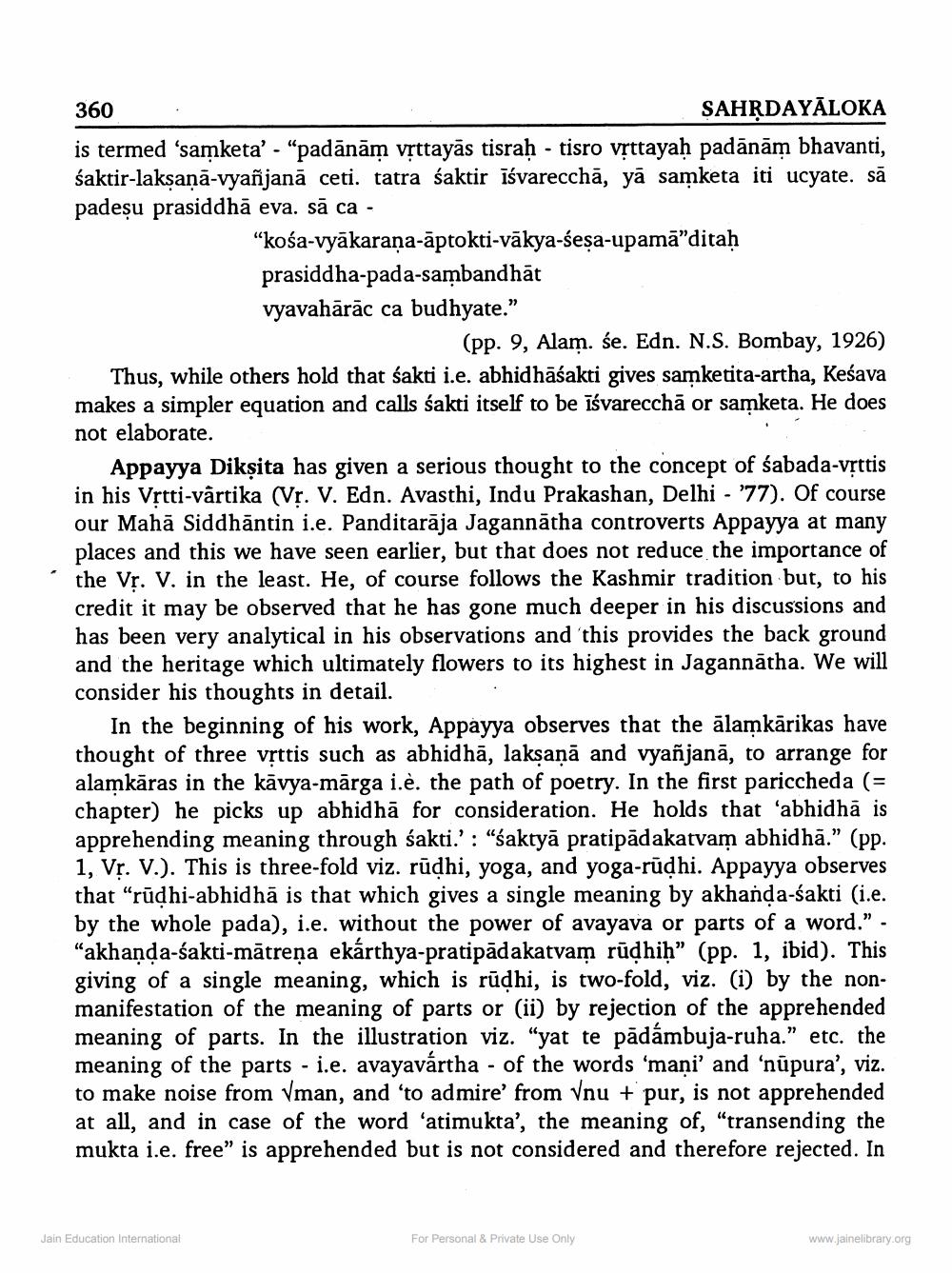________________
360
SAHṚDAYALOKA
is termed 'samketa' - "padānām vṛttayās tisraḥ - tisro vṛttayaḥ padānām bhavanti, śaktir-lakṣaṇā-vyañjanā ceti. tatra śaktir īśvarecchā, ya samketa iti ucyate. sā padeșu prasiddhā eva. să ca -
"kośa-vyākaraṇa-āptokti-vākya-seṣa-upamā"ditaḥ
prasiddha-pada-sambandhāt vyavahārāc ca budhyate."
(pp. 9, Alam. śe. Edn. N.S. Bombay, 1926) Thus, while others hold that sakti i.e. abhidhāśakti gives samketita-artha, Kesava makes a simpler equation and calls sakti itself to be iśvarecchā or samketa. He does not elaborate.
Appayya Dikṣita has given a serious thought to the concept of sabada-vṛttis in his Vṛtti-vārtika (Vr. V. Edn. Avasthi, Indu Prakashan, Delhi - '77). Of course our Mahā Siddhāntin i.e. Panditarāja Jagannatha controverts Appayya at many places and this we have seen earlier, but that does not reduce the importance of the Vr. V. in the least. He, of course follows the Kashmir tradition but, to his credit it may be observed that he has gone much deeper in his discussions and has been very analytical in his observations and this provides the back ground and the heritage which ultimately flowers to its highest in Jagannatha. We will consider his thoughts in detail.
Jain Education International
In the beginning of his work, Appayya observes that the alamkarikas have thought of three vṛttis such as abhidhā, lakṣaṇā and vyañjanā, to arrange for alamkāras in the kavya-mārga i.è. the path of poetry. In the first pariccheda (= chapter) he picks up abhidha for consideration. He holds that 'abhidha is apprehending meaning through śakti.': "śaktyā pratipādakatvam abhidhā." (pp. 1, Vr. V.). This is three-fold viz. rūḍhi, yoga, and yoga-rūḍhi. Appayya observes that "rudhi-abhidha is that which gives a single meaning by akhanḍa-śakti (i.e. by the whole pada), i.e. without the power of avayava or parts of a word." "akhaṇḍa-śakti-mātreņa ekárthya-pratipādakatvam rūḍhiḥ" (pp. 1, ibid). This giving of a single meaning, which is rūḍhi, is two-fold, viz. (i) by the nonmanifestation of the meaning of parts or (ii) by rejection of the apprehended meaning of parts. In the illustration viz. "yat te padámbuja-ruha." etc. the meaning of the parts - i.e. avayavártha - of the words 'mani' and 'nupura', viz. to make noise from √man, and 'to admire' from √nu + pur, is not apprehended at all, and in case of the word 'atimukta', the meaning of, "transending the mukta i.e. free" is apprehended but is not considered and therefore rejected. In
For Personal & Private Use Only
www.jainelibrary.org




